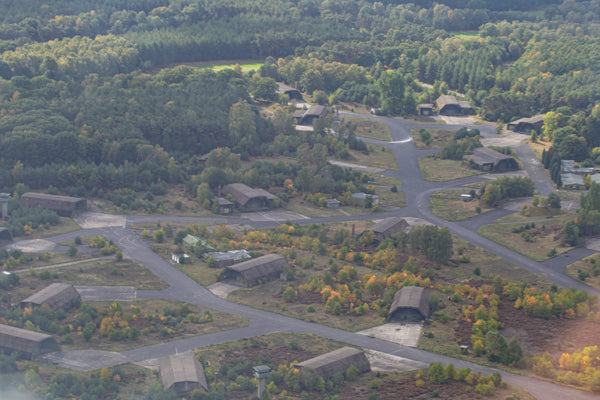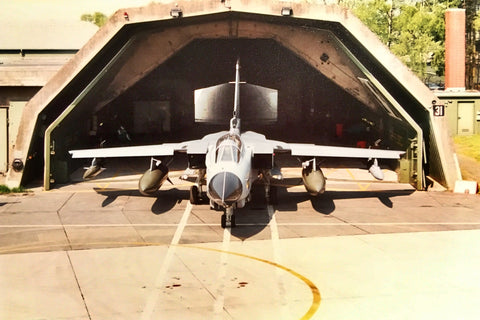The closure of the station that ended the RAF’s 56 years on German soil
IT was more than 20 years ago that a ceremony was held in Germany to mark the closure of the RAF’s last station in the country, ending a 56-year continued presence since the conclusion of the Second World War.
RAF Bruggen Station Sign available to purchase here
The government minister for the Armed Forces in 2001, Adam Ingram, made a speech at Brüggen, noting that the RAF had made a valuable contribution to the “peace and stability of Europe” as countries across the continent came to terms with what they believed was the end of the Cold War.
That optimism has been replaced by the fear that Cold War Two has begun with a vengeance, following Vladimir Putin’s decision to send his troops into Ukraine.
Those who served in the RAF in the post-war years will be well aware of exactly what the Cold War meant, with Britain at the forefront of NATO’s defence against the old USSR. At its peak presence in Germany, there were around 200 aircraft stationed at a dozen bases with 18,000 personnel, with Brüggen’s transfer to the British Army marking the end of the RAF’s 48-year presence on the site.
Situated around 30 miles west of Dusseldorf, Brüggen was one of a clutch of RAF station located near to the Dutch/Belgian border, sitting close to Wildenrath, Laarbruch and Geilenkirchen, all constructed to the west of the River Rhine to offer better protection against potential attacks from the east.
One of the first to set up home at Brüggen was the 317 Supply and Support Column, formed in 1944 for the vital role of supplying and equipping the Allied Forces fighting their way though Europe. By 1953 their remit included hauling freight from the docks at Antwerp – around 100 miles west of Brüggen – and delivering it to RAF stations across Germany; 317 remained at the station for around a decade.

(RAF Brüggen 📸 by Clemens Vasters)
Brüggen was geared up to accept the latest breed of aircraft coming into service, first occupied by a fighter wing equipped with Vampires, Sabres and Hunters, with squadrons operating at the station including 67, 71E, 112 and 130. The arrival of 87 Squadron at the station in 1957, equipped with Gloster Javelins, saw several squadrons deployed elsewhere or disbanded, and in the summer of 1957 the strike, attack and reconnaissance capabilities of the Canberra arrived at Brüggen. Around this time the station’s role had expanded, with the threat from the old Soviet Union seeing NATO extend their nuclear defensive capabilities in Germany.
The strike role of the station was passed to Phantoms in 1969, which in turn were replaced by Jaguars from 1975. Tornados started arriving at Brüggen in 1984, with four squadrons at the station – 14, 17, 31 and 9 – working alongside two others at Laarbruch to form the largest Tornado force in NATO.

(31 Sqn Tornado leaving it’s shelter at RAF Brüggen 📸 Denmen Aviation Photography)
Following the fall of the Berlin Wall and reunification of Germany, a decision was made in 1996 to remove all RAF assets from Germany, and five years later the departure was completed in a ceremony at Brüggen. The Tornado squadrons at Brüggen were the last RAF flying units to leave Germany, destined for RAF Marham in Norfolk.
The squadrons operating from Brüggen from the 1950s were 67, 71, 112, 130, all operating Sabres; 80 and 213 operating Canberras; No. 87 Squadron operating Gloster Javelins. Also based at Bruggen were No.37 Squadron, operating Rapiers; 14, 17 and 31, operating Phantoms, Jaguars and Tornados, No. 20 Squadron operating Jaguars, and No. 9 operating Tornados. Squadron No. 25 was at Brüggen from the early 1970s, the first squadron to operate the Bloodhound SAM. The station was also home to the RAF No. 431 maintenance unit.
Among the tragedies to befall airmen from RAF Brüggen, the Holt air collision saw a memorial unveiled to mark 50 years since the accident in Norfolk in August 1968. A Canberra from Brüggen was involved in a mid-air collision with a Victor tanker from RAF Marham during an electrical storm over Norfolk that had knocked out the radar systems. The Canberra had just completed a bombing exercise at the Wainfleet range off the Lincolnshire coast when it collided with the Victor, killing all seven airmen – three in the Canberra and four in the Victor.
The airmen killed were Stuart Cowie, John Woolnough and Johan Slabber aboard the Canberra; William Gallienne, Roger Morton, Kenneth Peacock and Michael Doyle on the Victor.
Brüggen was officially handed back to the German authorities in 2015 when the British Army departed from the Javelin barracks – plans are in the pipeline for an energy and industry park on the site.




